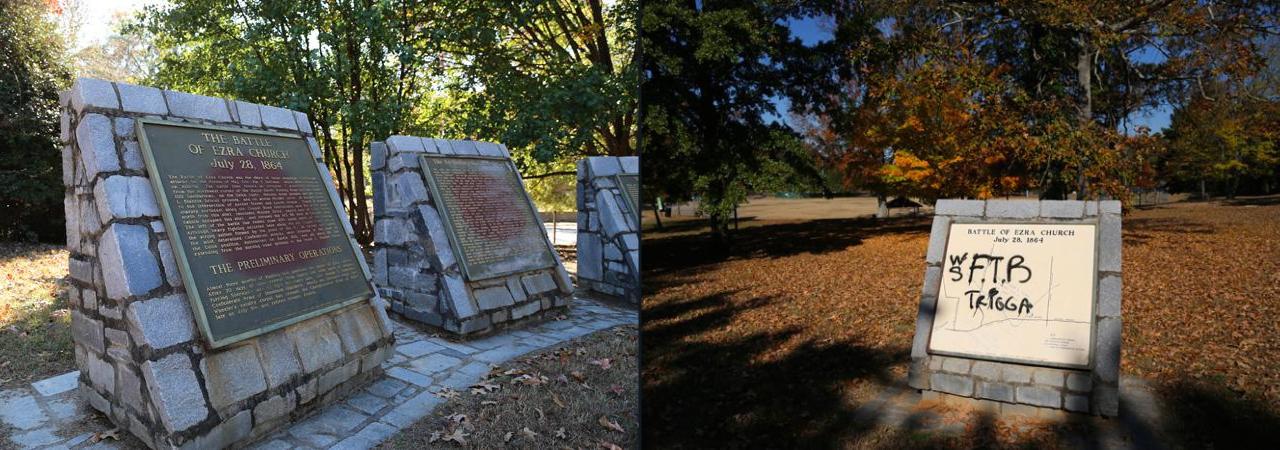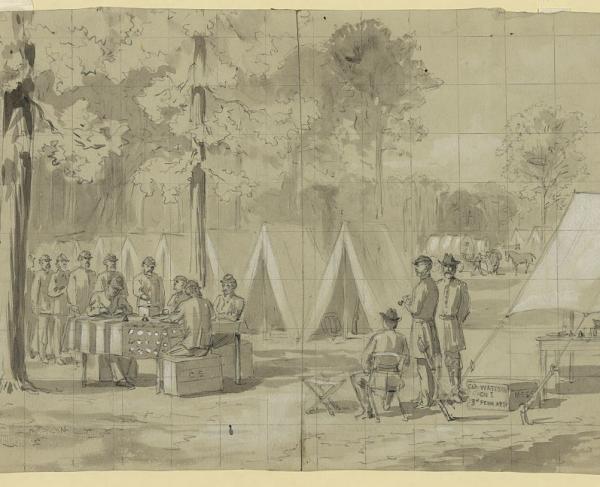
A series of historical markers describe the action here at Ezra Church on July 28, 1864.
July 1864 was an eventful month for the Confederate Army of Tennessee. President Jefferson Davis, who could no longer tolerate Gen. Joseph E. Johnston's "timid defensive" policy in Georgia, removed him from command on July 17 and replaced him with the younger, more aggressive, John Bell Hood. The message was clear: Hood was expected to drive the Yankees from the doorstep of the Gate City with an offensive stroke.
In his first ten days of army command, Hood waged three bloody battles that ushered in a violent phase of the campaign for Atlanta and the Civil War in the West. Despite near success at the battles of Peach Tree Creek, Atlanta, and Ezra Church, Hood failed to deliver the decisive blow the Confederate president so desired. In the process, he lost 11,000 irreplaceable men—more troops than Johnston had lost in the entire campaign up to that point. Hood continued his aggressive streak even after the fall of Atlanta, leading to bloody battles at Franklin and Nashville.
Despite the obvious importance of the battles for Atlanta, the battlefields at Peach Tree Creek, Atlanta, and Ezra Church have been completely lost to development. The following is a series of photos showing these sites as they appear today, providing a sad witness to the necessity of preservation.
Peach Tree Creek - July 20, 1864
Hood's first offensive stroke came on July 20, 1864, when he ordered his troops to attack the isolated Army of the Cumberland, just below a tributary of the Chattahoochee River called Peach Tree Creek. Hood caught the Yankees napping--in some cases literally--as many of the Federals were resting behind their main lines. Today, the site of the Union rear is occupied by the Bobby Jones Golf Course.

The fighting began in earnest around 4:00pm on July 20, when Lt. Gen. William Hardee's corps attacked the lone Federal division of Brig. Gen. John Newton. Behind hastily constructed barricades, Newton's men fended off Hardee's somewhat tepid attack, preventing the Rebels from turning the Yankee's vulnerable left flank. Today, the scene of Newton's stand is called "Cardiac Hill"--so named because Piedmont Hospital stands on the crest of the hill. A score of restaurants and stores surround the site.
Maj. Gen. Alexander P. Stewart's corps--formerly Hood's--came the closest to success on July 20, when they rolled up the exposed flank of Brig. Gen. John Geary's Twentieth Corps division, which was posted along today's Collier Road. Only swift-moving reinforcements--including the brigade of Col. Benjamin Harrison--prevented a Union disaster along Collier Road. This road was the scene of some of the heaviest fighting of the battle; today it is choked with urban traffic.

Battle of Atlanta - July 22, 1864
Following his defeat at Peach Tree Creek, Hood was looking for another way to get at the Yankees. He marched Hardee's corps 15 miles on the night of July 21, placing them in a position to strike the left flank of the Army of the Tennessee. Unfortunately for Hood, his roommate at West Point, Maj. Gen. James B. McPherson, commanded the Federals in this sector and was expecting such a maneuver. McPherson was in the act of scouting his lines when gray-clad skirmishers emerged from the woods and shot the general in his attempt to escape. Today, an upturned cannon marks the spot where McPherson was killed--now a residential neighborhood just south of I-20.
Confederate Maj. Gen. William H.T. Walker was another casualty of the battle. He was killed by Federal skirmishers just as attack began. Today, a monument to him can be found next to a gas station near the on-ramp to I-20.

The Battle of Atlanta reached a crisis when Maj. Gen. Benjamin F. Cheatham's division of Hardee's Corps breached the Union line near the Troup Hurt house. The onrushing Confederates temporarily captured the battery of Capt. Francis DeGress before fleet-footed Federals retook the battery and sealed the breach. This scene, which is one the central images of the Atlanta Cyclorama, took place in what is now a residential neighborhood. Only a handful of historic markers help visitors piece together this dramatic episode of the bloodiest battle of the Atlanta Campaign.

Maj. Gen. William T. Sherman watched the Battle of Atlanta unfold from his headquarters at the house of Augustus Hurt, Troup's brother. When Federals recovered McPherson's body, they brought it here, where Sherman paid his final respects to his beloved friend and subordinate. Today, the Hurt House site is on Coppen Hill, the site of the Jimmy Carter Presidential Library.
Battle of Ezra Church - July 28, 1864
The last of Hood's offensives around Atlanta is also one of the least photogenic battlefields in Atlanta. On July 28, Hood attempted to strike the Union right flank west of Atlanta. Instead, his troops ran into Maj. Gen. John Logan's Federals, who were well-entrenched. After a brief, bloody fight, Hood withdrew and planned his next move. Today, Mozley Park is the site of a few historic markers that explain the battle that raged through the park and the surrounding neighborhood.

Related Battles
1,750
2,500
3,722
5,500
642
3,000


